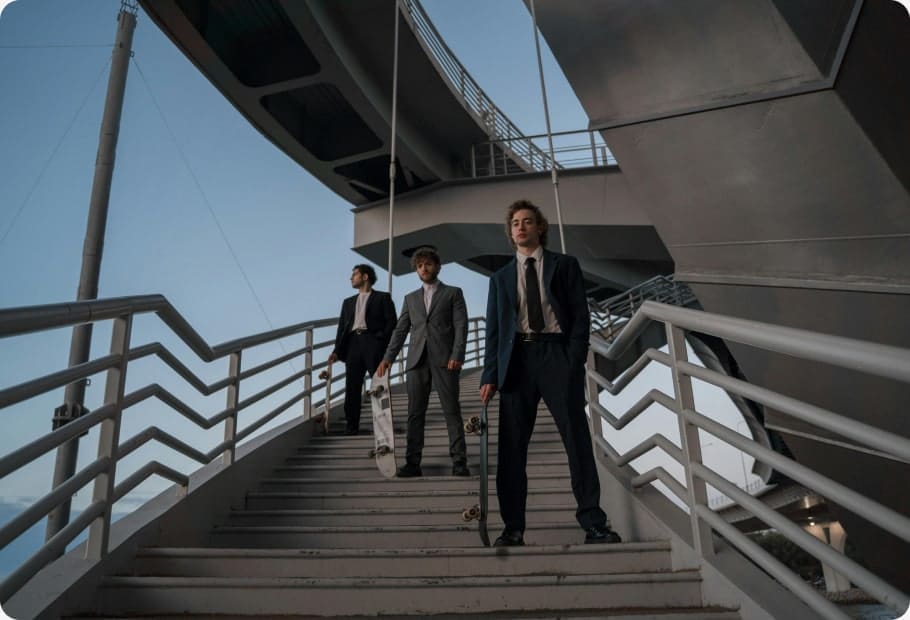Immersive website experiences: Unforgettable 2025
Why Immersive Website Experiences Are Revolutionizing Digital Engagement
Immersive website experiences are changing how visitors interact with brands. Instead of just displaying information, they pull users into interactive stories, 3D environments, and multi-sensory adventures, making them active participants.
Key characteristics of immersive website experiences:
- Interactive storytelling that guides users through branded narratives
- Multi-sensory elements including audio, video, and dynamic visuals
- Non-linear navigation that encourages exploration over traditional menu browsing
- Emotional engagement that creates memorable connections with your brand
- Participatory design where users control their journey through hover states, scrolling effects, and interactive hotspots
These websites break traditional UX rules to create what researchers call “encounters and journeys that make a novel and memorable impact on visitors.” As one industry expert notes, “These websites engage us on a deeper level… They draw us into their world and make us forget our own — if only for a moment.”
The shift toward immersive design reflects a change in user expectations. Modern users want to experience content, not just consume it. This is especially powerful for hospitality and creative businesses, where emotional connection drives brand loyalty. The psychology is simple: participation creates emotional investment, which leads to stronger brand recall and a higher likelihood of conversion.
I’m Christian Daniel, and over two decades of creating award-winning websites and video content for brands like The Plaza Hotel, I’ve seen how immersive website experiences can transform visitor engagement and drive measurable business results. My approach combines cinematic storytelling with strategic web design to create digital journeys that don’t just inform–they captivate and convert.
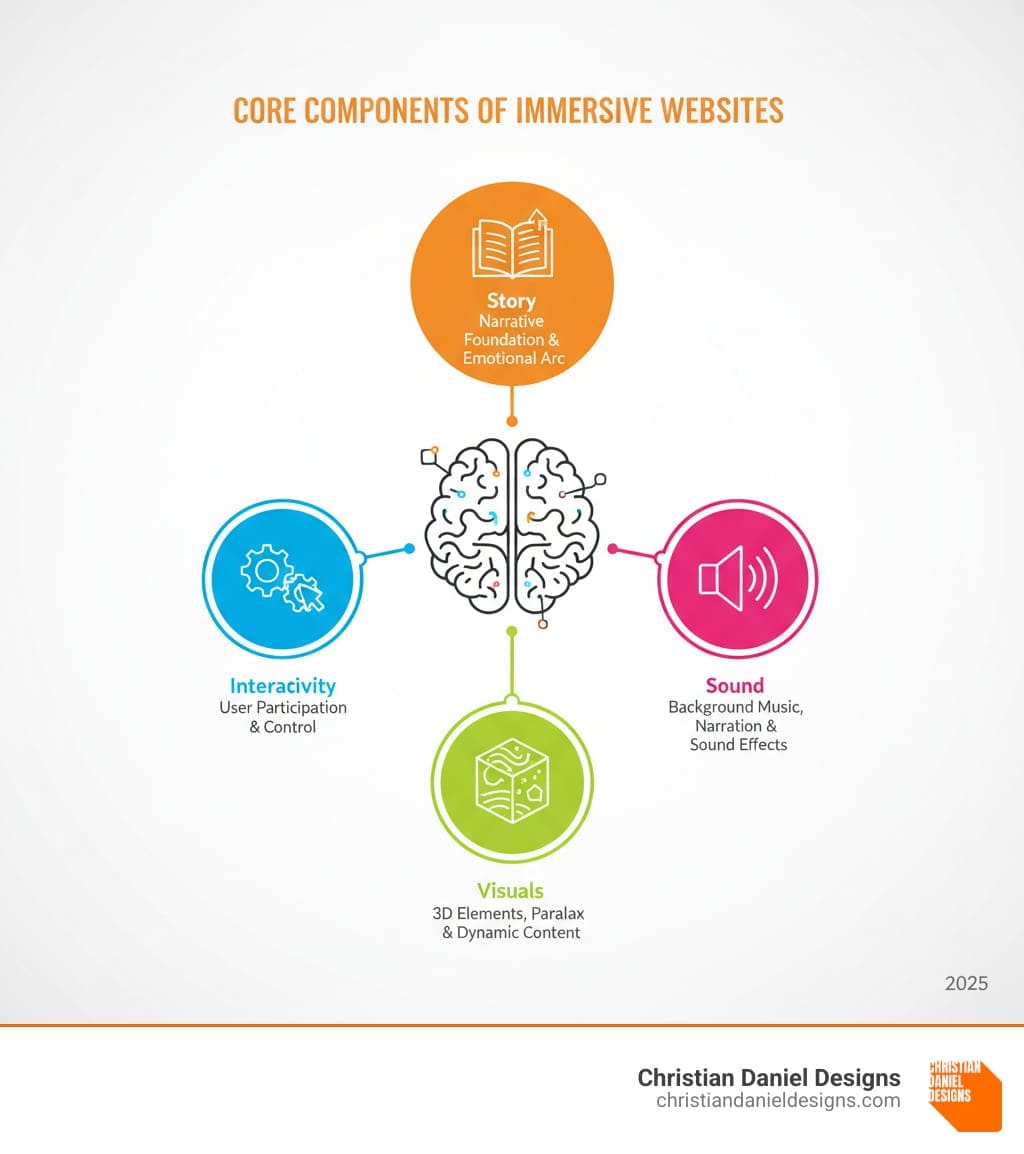
What is an Immersive Website Experience?
An immersive website experience is a digital journey where every scroll or click reveals something new. Imagine floating through a 3D hotel lobby or watching a product’s story come to life as you move your mouse. It’s a digital environment that creates a multi-sensory adventure, making you the main character.
Think of it as the difference between a flat travel brochure and actually stepping into the destination. Immersive sites let you explore at your own pace, find hidden details, and feel genuinely excited. By engaging multiple senses with background music, responsive visuals, and interactive storytelling, these sites build emotional connection. You stop thinking about the technology and start feeling something for the brand, creating an experience you’ll remember and share.
How Immersive Websites Differ from Traditional Web Design
Traditional websites follow a familiar, efficient playbook: homepage, navigation menu, click, and find. They are built on traditional UX rules to help users find information quickly.
Immersive websites tear up that playbook. Instead of linear navigation, you might scroll horizontally through a story or use your mouse to explore a 3D space. The content experience is transformed. Rather than just reading text, you might participate in animated sequences or see the world from a first-person perspective.
| Feature | Traditional Websites | Immersive Websites |
|---|---|---|
| Structure | Static pages with clear hierarchy | Dynamic, journey-based experiences |
| Navigation | Menu-driven, predictable paths | Non-linear, exploration-focused |
| User Role | Information seeker | Active participant and explorer |
| Content Style | Text-heavy, informational | Experiential, multi-sensory |
| Primary Goal | Efficient task completion | Emotional connection and engagement |
The beauty of this approach is that it gives users user control in a new way. You’re not just choosing from a menu; you’re choosing how to experience a story. This shift from passive viewing to active user participation creates memories that stick. At Christian Daniel Designs, our Web Design services focus on creating these meaningful digital journeys.
The Psychology of Engagement and Immersion
Human psychology shows that the more effort we put into something, the more we value it. As psychologist Eliot Aronson notes in The Social Animal, active participation makes an experience more enjoyable.
This user justification is powerful. When a user interacts with your site, they invest attention and energy, making them more likely to remember the experience and feel positive about your brand. This creates self-fulfilling enjoyment. Users are entertained because they are active participants, not passive observers. This is why immersive experiences are so effective for brand recall. People describe what they did on your site, not just what they saw.
The element of escapism is also key. An experience that fully captures attention is precious in our distracted world. When a site makes users forget their surroundings, it creates memorable experiences that stand out. For businesses, especially in hospitality, these Psychological principles of interaction are transformative. People buy feelings and stories, not just products or services.
The Building Blocks: Key Techniques for Crafting Immersive Experiences
Building an immersive website experience is like orchestrating a symphony. After two decades of crafting digital experiences, I’ve learned the secret is combining creative vision with technical precision. The process starts with understanding your brand’s story and selecting the right interactive elements to bring it to life.
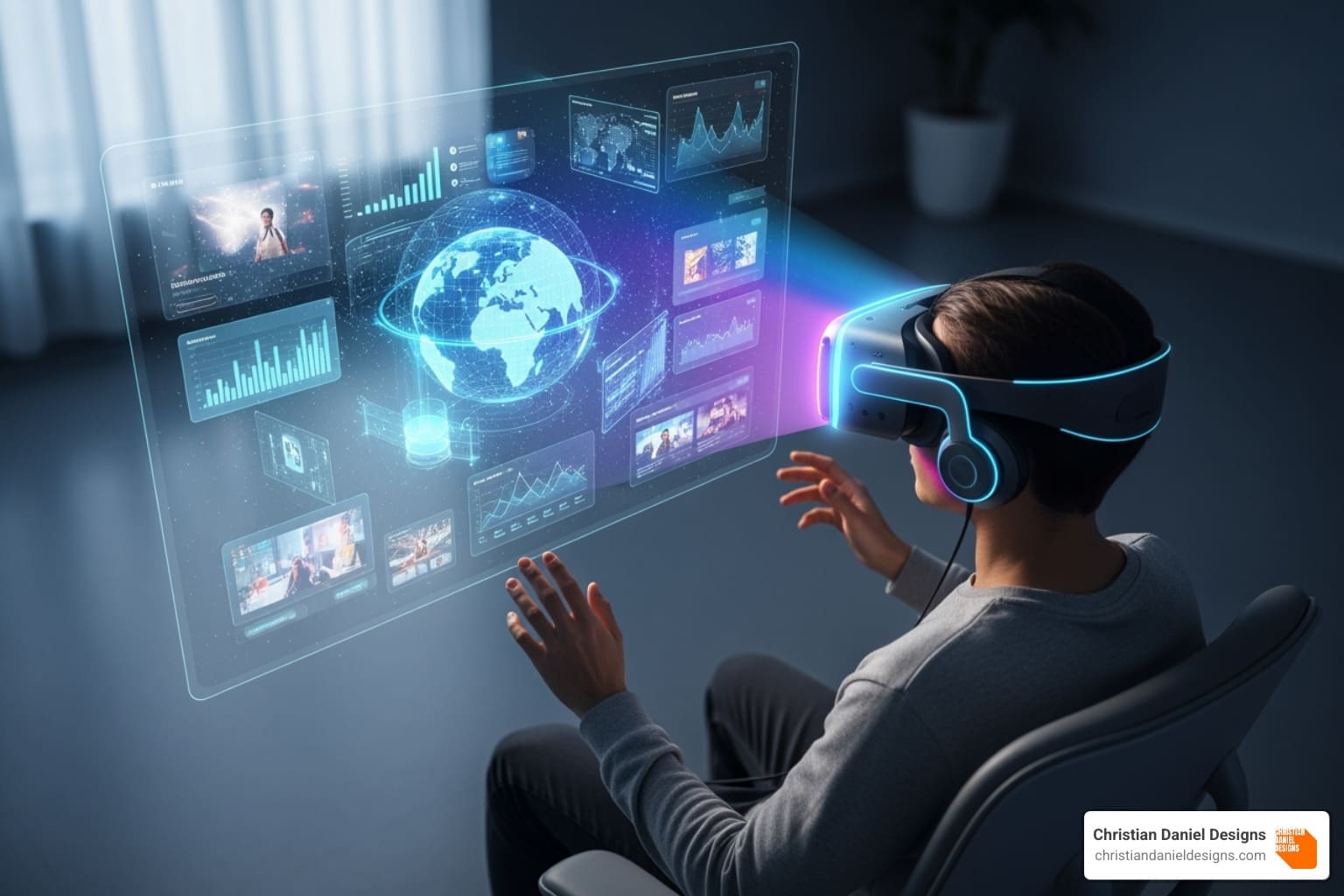
My development process is deeply collaborative. We use custom development platforms and custom solutions to push the boundaries of what’s possible, creating experiences that are visually stunning, technically robust, and fast. If you’re curious about the technical possibilities, explore our custom development services to see how we build unique digital presences.
The Power of Narrative: Storytelling as the Foundation
Every compelling immersive website experience begins with a story. Narrative gives meaning to every interaction, connecting animations and effects into something that matters to your audience. The most memorable websites take visitors on an emotional journey, making them part of the story. For example, an interactive storybook can bring a narrative to life through digital interaction. We use the power of storytelling through video to create these deeper connections, turning simple website visits into memorable brand encounters.
Visual and Interactive Elements
The visual components are where creativity meets technology, changing static pages into dynamic, responsive environments.
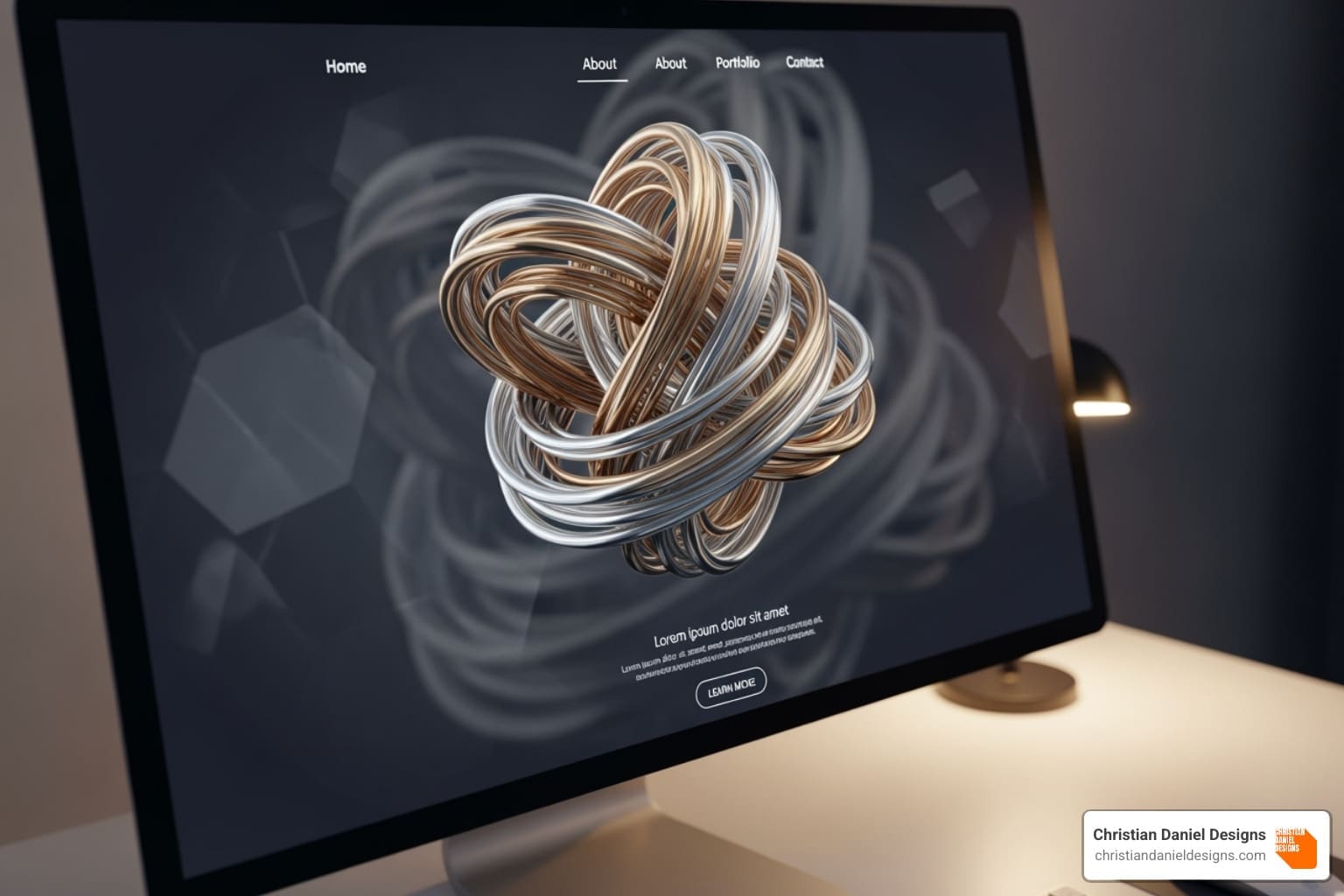
3D visuals bring a realism that flat designs can’t match. Imagine letting visitors rotate, zoom, and explore your products in a virtual space.
Parallax scrolling creates a cinematic feeling, where background and foreground elements move at different speeds to add depth.
Horizontal scrolling breaks from the usual vertical flow, encouraging a more intentional interaction with your content. It’s perfect for presenting a timeline or a step-by-step process.
Micro-interactions and hover states are small details that make a big difference. These tiny moments of feedback make websites feel alive and responsive.
Gamification elements like challenges or puzzles can transform a site visit into an engaging adventure, encouraging exploration and making time on site more enjoyable.
The Role of Audio and Video
Sound and motion complete the immersive puzzle, turning visual experiences into multi-sensory journeys.
Background music and sound effects create atmosphere without being intrusive. Think of an ocean conservation site with gentle wave sounds.
Narration adds a personal, human touch, guiding users through complex information or telling your brand story with emotional depth.
Full-screen video immediately captures attention with dynamic motion. We specialize in creating award winning video content that transforms websites into cinematic experiences.
360-degree video and environments offer the ultimate in digital immersion, allowing visitors to explore a space as if they were physically there. A site with 360-degree video shows how this technology can create incredible depth and user-controlled exploration.
The key is balance–each element should serve the story, not just show off technology. When done right, these building blocks create immersive website experiences that truly engage and inspire.
Award-Winning Immersive Website Examples
The most compelling immersive website experiences don’t just look beautiful–they transform how visitors connect with brands. These digital journeys prove that when creativity meets strategic design, the results can be truly extraordinary.
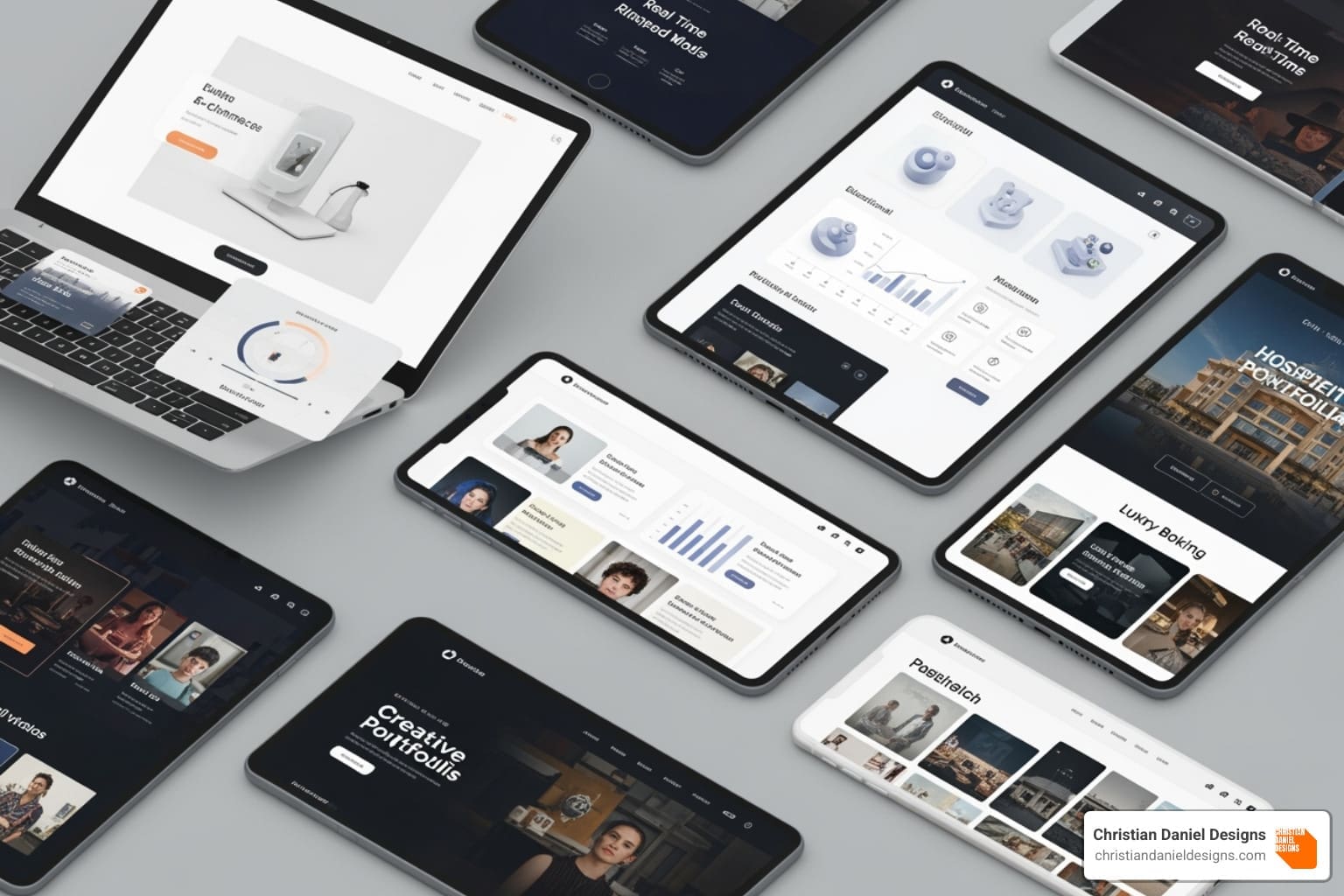
I’ve had the privilege of creating these transformative experiences for clients across various industries. Each project teaches us something new about what makes visitors truly engaged. Our portfolio of hotel website designs showcases how we apply these immersive principles to create unforgettable brand experiences.
Immersive Experiences in E-commerce and Retail
Smart e-commerce brands know that selling online is about creating desire through experience. Immersive retail sites go beyond product galleries to forge emotional connections that drive purchases. For example, Gucci’s Flora fragrance website turns shopping into an adventure. Visitors explore an animated world, interacting with content that reveals the perfume’s story, making them feel the fragrance’s essence. Experience it at Gucci’s luxury fragrance experience. Effective sites use virtual try-on technology, 3D product configurators, and interactive storytelling to entertain and engage. We’ve applied these principles in our own work, creating an e-commerce website that turns browsing into a journey.
Immersive Experiences in Hospitality and Travel
In hospitality, you’re selling a dream. Immersive websites excel here by transporting potential guests to your property before they book. Successful hospitality sites use virtual tours, interactive maps, and destination storytelling to build excitement and confidence. Our work on The Plaza Hotel Website and Commercial demonstrates how luxury hospitality comes alive through immersive digital experiences. Similarly, Google’s “Beyond the Map” project creates a deep connection with Rio de Janeiro through 360-degree views and personal stories, allowing users to experience the city’s culture. Explore this journey at Google’s interactive city exploration.
Immersive Experiences for Education and Awareness
Immersive experiences can make complex topics engaging. They turn dry information into interactive adventures that stick with visitors. The Blue Marine Foundation’s “The Sea We Breathe” website is a perfect example. Instead of just listing facts, it takes users on underwater “journeys” through 3D ocean scenes, making educational content feel like a documentary you control. The genius lies in using gamified learning and interactive data visualization to make complex topics accessible. Experience this impactful journey at The Blue Marine Foundation’s educational site. We’ve applied similar principles in our non-profit website design work, helping organizations create meaningful connections.
The best immersive experiences make visitors active participants in the brand story. That’s the difference between a website someone visits and one they remember.
Best Practices for Designing Immersive Website Experiences
Creating an immersive website experience requires vision, technical skill, and a deep understanding of your audience. The most captivating websites are thoughtfully designed with the user at the center of every decision.
User-centric design is the foundation. Even when breaking traditional rules, the experience must feel intuitive. Provide clear navigation cues–subtle hints or prompts–so users can explore without frustration.
Performance optimization is critical. Heavy assets like 3D models and videos can slow things down, killing the immersive effect. We optimize every asset to ensure a smooth experience on any device or connection speed.
With most visitors on their phones, a mobile-first approach is fundamental. Every interaction must translate beautifully to smaller touch screens.
Accessibility considerations are also paramount. We ensure users with disabilities can engage through features like alt text and keyboard navigation. Great design is inclusive.
As one expert puts it, you should “build an immersive experience around communicating a single story or with a specific goal and user-action in mind.” Don’t try to do everything at once. Focus on one core objective and build the experience around it, ideally as a contained experience on a single page or in closely linked sections. This keeps users from getting sidetracked. Maintaining these complex sites requires ongoing attention, which is why our website maintenance services are so valuable.
Measuring the Success of Your Immersive Website
An immersive website is an investment, and its success must be measured. While traditional metrics matter, we also look at:
- Dwell time: How long visitors stay engaged. More time indicates deeper engagement.
- Interaction rate: How actively users click, drag, and explore. It shows participation, not just passive consumption.
- Scroll depth: How much of the narrative journey users complete.
- Conversion goals: Whether the experience drives business outcomes like signups or purchases.
- Social shares and mentions: When users are excited enough to share, it’s a sign you’ve created something memorable.
- Brand sentiment analysis: Understanding the emotional impact and how people talk about your brand after the experience.
Understanding the return on investment is complex, but these KPIs help gauge effectiveness. Our insights into The ROI of Video Marketing offer perspective on measuring engagement for dynamic content.
The Future of Immersive Web Experiences
The web is evolving, and the future of immersive experiences is exciting.
- Augmented Reality (AR) will blend digital and physical worlds, letting users place virtual furniture in their living room through their phone.
- Virtual Reality (VR) will allow users to step completely inside branded worlds as headsets become more common.
- WebGL advancements continue to enable more sophisticated 3D graphics directly in browsers without plugins.
- AI-powered personalization is the most exciting frontier, promising unique journeys for every visitor based on their behavior. This aligns with our work in AI Product Video services, where we already use AI to create dynamic content.
- The Metaverse suggests a future of interconnected virtual worlds, with websites acting as gateways.
These advances mean immersive experiences will become even more personalized and essential to brand strategy. The web is becoming a portal to limitless digital worlds.
Frequently Asked Questions about Immersive Website Experiences
I get these questions all the time when talking with clients about creating truly engaging digital experiences. Here are some honest answers based on over two decades of building websites.
How much does an immersive website cost?
The cost depends on the complexity. A site with simple parallax scrolling will cost less than one with full 3D environments and custom audio. The investment is typically higher than a standard website due to the specialized skills involved, like custom development and 3D modeling. However, brands that invest in memorable experiences see real returns in engagement and conversions. I work directly with every client to find the right balance between their vision, budget, and business goals.
Are immersive websites bad for SEO?
This is a myth. A well-built immersive website experience can actually boost your SEO. When people spend more time on your site, share it on social media, and don’t bounce away, search engines see that as a sign of quality. The key is proper technical optimization. A fast-loading, mobile-friendly immersive site can outperform traditional websites in search rankings.
Can my small business benefit from an immersive website?
Absolutely. This is where you have an advantage. While larger competitors may have boring corporate sites, you can be bold and memorable. I’ve seen small hospitality brands and local businesses use immersive experiences to stand out in crowded markets. A boutique hotel can offer a virtual tour, or a restaurant can tell its story interactively. Your size isn’t a limitation–it’s your secret weapon for creating something personal and engaging that larger brands can’t match.
Conclusion
The web has evolved from simple information sharing to a stage for memorable immersive website experiences. We’ve explored how these digital adventures break from traditional design, using psychology to make users stay, explore, and remember.
We’ve seen that narrative storytelling, 3D visuals, parallax effects, and custom audio and video are the essential building blocks. Examples from Gucci to the Blue Marine Foundation prove that immersive experiences work across all industries, creating connections that traditional sites can’t.
Looking ahead, technologies like augmented reality and AI-powered personalization will expand the possibilities even further. What’s most exciting is that these experiences aren’t just for tech giants. Small businesses and hospitality brands can use immersive design to tell their unique stories and build lasting customer relationships.
At Christian Daniel Designs, I’ve spent over twenty years combining cinematic storytelling with strategic web development to create experiences that drive real business results. The future of the web is about making people feel something, not just showing them something.
Ready to create an immersive website experience that captivates your audience and sets your brand apart? Explore our award-winning hotel website designs to see immersion in action and find how we can help your brand create unforgettable digital moments.







